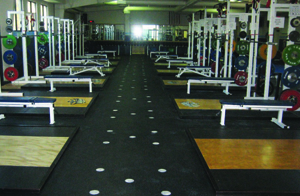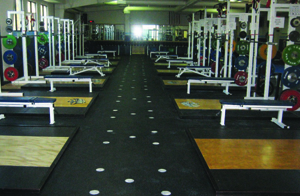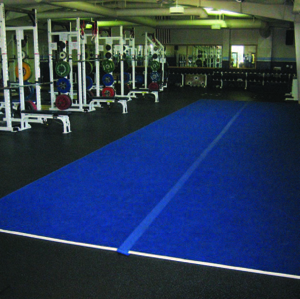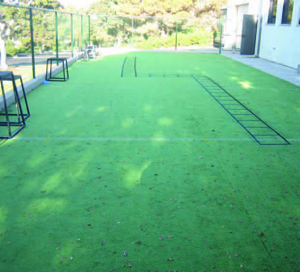University of San Diego Weightroom Retrofit

In February, 2007, I was hired as the Head Strength and Conditioning Coach at the University of San Diego. For anyone who has been to San Diego and visited this campus, you know that one could not ask for a more beautiful place to work.
USD is a small private school with an enrollment of approximately 6000 students. The Toreros compete in the West Coast Conference (Division I) and in the Pioneer Football League (Division IAA). Our stadium, baseball field and practice fields are top notch facilities. And the weight room is one of the reasons I was thrilled to get this job.
The Varsity Weight Room is the weight training facility for all 16 varsity teams (approximately 420 student-athletes). It is 5000 square feet of open floor space with a handy roll-up door at one end. There is also a 1600 square foot turf area right outside the weight room.
When I arrived, the weight room had eight, 8 X 8 platforms and four, 6 X 6 platforms. These were arranged in three rows of four platforms with approximately 10 -12 feet separating the rows. On one wall, the four racks supported squat stands. In the middle of the room, double-sided Samson power racks covered the platforms. On the opposite wall, the smaller platforms carried Samson half-racks. Amongst all of these platforms, were 16 adjustable benches and 4 complete sets of Uesaka bumper plates. A few other miscellaneous bumpers were scattered in 6 plate holders. The racks also held sets of metal plates. A full set of dumbbells (2 pairs of each weight from 5 lbs to 75 lbs) up to 150 lbs was located in the back of the room. Finally, several old machines (leg curl, leg extension…) as well as 4 Samson Glute-Hams were placed haphazardly near the entrance of the weight room.

Each platform had a bar: either an old York weightlifting bar, or a cheap power bar. The rotation on most of these bars was minimal. In addition, the power bars were 32mm thick (versus 28mm for weightlifting bars). This “thick” grip and lack of rotation made power cleans with these bars difficult, especially for female athletes. Also, Uesaka bumpers and York bars do not mix. The bumpers get jammed on the bar and have to be hammered off. This is a frustrating problem in the middle of a fast paced workout.
The training philosophies I had been taught at Ohio, UCLA and in Coach Burgener’s garage fit nicely in this environment. Basically, I am a big proponent of the Olympic lift variations (power clean, hang clean, clean and jerk, power snatch…), deep squats (front, back overhead), various pressing and pulling movements and calisthenics.

When training a team, I assign three athletes to a platform and then I guide the entire team through the workout. Everyone on the team does the same exercise at the same time so they all see how their teammates perform the exercises and they all receive the same coaching cues. This method also fosters a competitive atmosphere. Athletes who perform an exercise well may be asked to demonstrate for the group. The athletes are coached through every phase of the workout, from the warm-up to the cool-down. The workout itself is posted on the whiteboard and the weights to be used are on “number sheets” at each rack. These sheets are constantly updated by the strength coaches. Everyone starts in the same spot and finishes at the same time. We do not have athletes milling around, moving from exercise to exercise on their own time, and filling out their own cards.
With this training philosophy in mind, and after carefully studying the weight room schedule, the number of athletes we had to train and the current layout, we set these requirements for the weight room:
a) The ability to train more than one team at a time or to train the football team in two large groups (approx. 50 athletes per group).
b) The ability to do all of our major work on the platform to keep workouts organized and flowing smoothly.
c) The ability to have teams working out on the same exercises at the same time as described above.
In my first few weeks, we did very little to reorganize the weight room set-up. We spent most of the time coaching and implementing my training system/philosophy. A lot of time was spent experimenting with different potential set-ups. We did get rid of the old machines (purchased by a local high school through the Athletic Facilities Staff) and cleared out some small pieces of equipment I knew we would not be using (such as a broken bike and treadmill). Any loose odds and ends (chains, med balls…) were taken off the floor and properly stored. This helped to make the weight room look cleaner and larger.
When Spring Break arrived, it was time to make a major change. We took the Samson half racks off of the smaller platforms. These platforms were then removed from the weight room. We built four new 8 x 8 platforms the way Coach Burgener taught me. That is, two sheets of 4x8 plywood facing north/south covered by two sheets facing east/west. Then one sheet of 4x8 plywood centered on top and 2x8 strips of horse stall mats on either side to complete the platforms. Everything was glued and screwed down.
These platforms were placed on each end of the two remaining rows of platforms. This created two rows of six platforms facing each other. Our facility welders made cast iron metal frames for the platforms and we bolted the Samson half racks on top. This setup allowed us to clearly see all the athletes as they performed their lifts. In addition, by moving the platforms away from one wall, we created a large open space on one side of the weight room. More on that later.
We now had 12 platforms, eight racks (four are double-sided) and four squat stands. But we did not have anywhere near enough weight! So we took a big chunk of our budget and ordered more bumper plates. Having used Eleiko for most of my time as a coach, I ordered several sets of these. I then took advantage of an incredible deal offered by Werksan and ordered five pairs each of 25 KG and 10 KG plates. I have to say, the quality and look of the Werksan plates is outstanding and their customer service was unbelievable. I plan on ordering many more Werksan plates in the future.
With these bumper plate orders, we now had a full set of bumpers at each platform and a double set on the platforms with the double-sided racks. (We use both sides of the racks as lifting stations. Athletes lift off the platform on one side, and the other side, they lift off plywood we set in the floor by cutting out the rubber flooring.)
Next, we ordered four Legend Half Racks through Eddie Lugo at CrossFit San Diego. Here again, the customer service was fantastic. We replaced our squat stands with these racks, giving us a pullup bar at each platform. We were also able to remove the plate holders from the floor and store our bumper plates and metal plates on the racks. This helped with cleanliness and traffic flow.
Next, we ordered 16 sets of rings from Eddie Lugo at CrossFit San Diego. These are his design and we love them. They are easy to move and attach so we can take them down to the field when we do workouts down there. These were a much cheaper and much more versatile alternative to the regular dip attachments for power racks. We are now able to do ring dips, ring pushups (multiple variations), ring pullups, ring abs and muscle ups at every platform. This has been a huge addition to our program.

As the new budget year began in July, we were able to make a few more additions to the room. Once again with the help of CrossFit San Diego, we were able to purchase 10 Pendlay weightlifting bars, giving us a total of 16 quality bars. We also filled the open side of the weight room by adding a tumbling mat (42’x12’) for tumbling, agilities, dynamic mobility, flexibility, prehab/rehab and abdominal exercises. Finally, Coach Burgener put us in contact with www.hitechplates.com, where we purchased some indestructible technique plates for teaching the Olympic lifts.
The final and most important piece of the puzzle came in mid-July. The athletic department provided the funds for 2 additional assistant coaches. We were able to make incredible additions to our staff by hiring LaKeysha McClenton and Skipp Benzing. McClenton was a track star at Cal State Fullerton and is a nationally ranked weightlifter. Benzing played baseball in the Red Sox organization. Both have numerous years of coaching experience and bring with them tons of knowledge and energy. They will definitely make the most out of the space we have created and will be counted on for new ideas.
So where do we go from here? Well, we have a long wish list. In the next year, depending on our fundraising efforts, we hope to purchase kettlebells and sandbags. We want to get hurdles for mobility drills and hope to build a pullup/rope/cargo net course. And of course, we are very envious of “The Patch” Josh Everett built at UCR. Our goal is simple: to get better every year in order to provide more effective, varied and “fun” training for our student-athletes.
*If you live in the San Diego area and would like specialized coaching in the Olympic lifts, speed or general conditioning and strength training, please contact us srochet@sandiego.edu.
USD is a small private school with an enrollment of approximately 6000 students. The Toreros compete in the West Coast Conference (Division I) and in the Pioneer Football League (Division IAA). Our stadium, baseball field and practice fields are top notch facilities. And the weight room is one of the reasons I was thrilled to get this job.
The Varsity Weight Room is the weight training facility for all 16 varsity teams (approximately 420 student-athletes). It is 5000 square feet of open floor space with a handy roll-up door at one end. There is also a 1600 square foot turf area right outside the weight room.
When I arrived, the weight room had eight, 8 X 8 platforms and four, 6 X 6 platforms. These were arranged in three rows of four platforms with approximately 10 -12 feet separating the rows. On one wall, the four racks supported squat stands. In the middle of the room, double-sided Samson power racks covered the platforms. On the opposite wall, the smaller platforms carried Samson half-racks. Amongst all of these platforms, were 16 adjustable benches and 4 complete sets of Uesaka bumper plates. A few other miscellaneous bumpers were scattered in 6 plate holders. The racks also held sets of metal plates. A full set of dumbbells (2 pairs of each weight from 5 lbs to 75 lbs) up to 150 lbs was located in the back of the room. Finally, several old machines (leg curl, leg extension…) as well as 4 Samson Glute-Hams were placed haphazardly near the entrance of the weight room.

Each platform had a bar: either an old York weightlifting bar, or a cheap power bar. The rotation on most of these bars was minimal. In addition, the power bars were 32mm thick (versus 28mm for weightlifting bars). This “thick” grip and lack of rotation made power cleans with these bars difficult, especially for female athletes. Also, Uesaka bumpers and York bars do not mix. The bumpers get jammed on the bar and have to be hammered off. This is a frustrating problem in the middle of a fast paced workout.
The training philosophies I had been taught at Ohio, UCLA and in Coach Burgener’s garage fit nicely in this environment. Basically, I am a big proponent of the Olympic lift variations (power clean, hang clean, clean and jerk, power snatch…), deep squats (front, back overhead), various pressing and pulling movements and calisthenics.

When training a team, I assign three athletes to a platform and then I guide the entire team through the workout. Everyone on the team does the same exercise at the same time so they all see how their teammates perform the exercises and they all receive the same coaching cues. This method also fosters a competitive atmosphere. Athletes who perform an exercise well may be asked to demonstrate for the group. The athletes are coached through every phase of the workout, from the warm-up to the cool-down. The workout itself is posted on the whiteboard and the weights to be used are on “number sheets” at each rack. These sheets are constantly updated by the strength coaches. Everyone starts in the same spot and finishes at the same time. We do not have athletes milling around, moving from exercise to exercise on their own time, and filling out their own cards.
With this training philosophy in mind, and after carefully studying the weight room schedule, the number of athletes we had to train and the current layout, we set these requirements for the weight room:
a) The ability to train more than one team at a time or to train the football team in two large groups (approx. 50 athletes per group).
b) The ability to do all of our major work on the platform to keep workouts organized and flowing smoothly.
c) The ability to have teams working out on the same exercises at the same time as described above.
In my first few weeks, we did very little to reorganize the weight room set-up. We spent most of the time coaching and implementing my training system/philosophy. A lot of time was spent experimenting with different potential set-ups. We did get rid of the old machines (purchased by a local high school through the Athletic Facilities Staff) and cleared out some small pieces of equipment I knew we would not be using (such as a broken bike and treadmill). Any loose odds and ends (chains, med balls…) were taken off the floor and properly stored. This helped to make the weight room look cleaner and larger.
When Spring Break arrived, it was time to make a major change. We took the Samson half racks off of the smaller platforms. These platforms were then removed from the weight room. We built four new 8 x 8 platforms the way Coach Burgener taught me. That is, two sheets of 4x8 plywood facing north/south covered by two sheets facing east/west. Then one sheet of 4x8 plywood centered on top and 2x8 strips of horse stall mats on either side to complete the platforms. Everything was glued and screwed down.
These platforms were placed on each end of the two remaining rows of platforms. This created two rows of six platforms facing each other. Our facility welders made cast iron metal frames for the platforms and we bolted the Samson half racks on top. This setup allowed us to clearly see all the athletes as they performed their lifts. In addition, by moving the platforms away from one wall, we created a large open space on one side of the weight room. More on that later.
We now had 12 platforms, eight racks (four are double-sided) and four squat stands. But we did not have anywhere near enough weight! So we took a big chunk of our budget and ordered more bumper plates. Having used Eleiko for most of my time as a coach, I ordered several sets of these. I then took advantage of an incredible deal offered by Werksan and ordered five pairs each of 25 KG and 10 KG plates. I have to say, the quality and look of the Werksan plates is outstanding and their customer service was unbelievable. I plan on ordering many more Werksan plates in the future.
With these bumper plate orders, we now had a full set of bumpers at each platform and a double set on the platforms with the double-sided racks. (We use both sides of the racks as lifting stations. Athletes lift off the platform on one side, and the other side, they lift off plywood we set in the floor by cutting out the rubber flooring.)
Next, we ordered four Legend Half Racks through Eddie Lugo at CrossFit San Diego. Here again, the customer service was fantastic. We replaced our squat stands with these racks, giving us a pullup bar at each platform. We were also able to remove the plate holders from the floor and store our bumper plates and metal plates on the racks. This helped with cleanliness and traffic flow.
Next, we ordered 16 sets of rings from Eddie Lugo at CrossFit San Diego. These are his design and we love them. They are easy to move and attach so we can take them down to the field when we do workouts down there. These were a much cheaper and much more versatile alternative to the regular dip attachments for power racks. We are now able to do ring dips, ring pushups (multiple variations), ring pullups, ring abs and muscle ups at every platform. This has been a huge addition to our program.

As the new budget year began in July, we were able to make a few more additions to the room. Once again with the help of CrossFit San Diego, we were able to purchase 10 Pendlay weightlifting bars, giving us a total of 16 quality bars. We also filled the open side of the weight room by adding a tumbling mat (42’x12’) for tumbling, agilities, dynamic mobility, flexibility, prehab/rehab and abdominal exercises. Finally, Coach Burgener put us in contact with www.hitechplates.com, where we purchased some indestructible technique plates for teaching the Olympic lifts.
The final and most important piece of the puzzle came in mid-July. The athletic department provided the funds for 2 additional assistant coaches. We were able to make incredible additions to our staff by hiring LaKeysha McClenton and Skipp Benzing. McClenton was a track star at Cal State Fullerton and is a nationally ranked weightlifter. Benzing played baseball in the Red Sox organization. Both have numerous years of coaching experience and bring with them tons of knowledge and energy. They will definitely make the most out of the space we have created and will be counted on for new ideas.
So where do we go from here? Well, we have a long wish list. In the next year, depending on our fundraising efforts, we hope to purchase kettlebells and sandbags. We want to get hurdles for mobility drills and hope to build a pullup/rope/cargo net course. And of course, we are very envious of “The Patch” Josh Everett built at UCR. Our goal is simple: to get better every year in order to provide more effective, varied and “fun” training for our student-athletes.
*If you live in the San Diego area and would like specialized coaching in the Olympic lifts, speed or general conditioning and strength training, please contact us srochet@sandiego.edu.
|
Stephane Rochet was hired as the Head Strength and Conditioning Coach at the University of San Diego in January 2007. Prior to this, he was a strength coach at UCLA, Indiana University and UCR. His training philosophy has been heavily influenced by Coach Burgener, Josh Everett, Ethan Reeve and CrossFit. |
Search Articles
Article Categories
Sort by Author
Sort by Issue & Date
Article Categories
Sort by Author
Sort by Issue & Date

